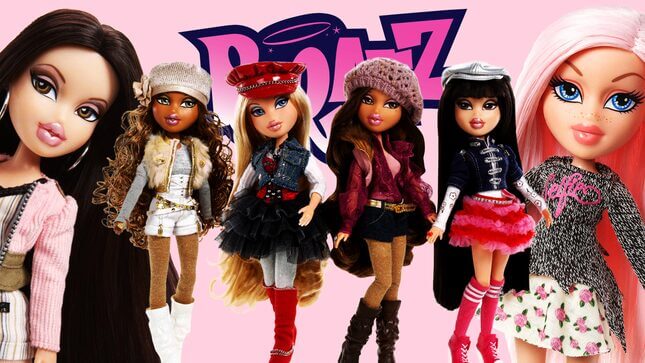
Graphic: Elena Scotti (Photos: AP, Amazon.com)
Earlier this month Desiree Machado, a 15-year-old YouTuber with nearly one million subscribers, filmed herself getting ready to hit the local fair. Like many high school sophomores, she was preparing to spend one of the last weekends of summer riding rides and eating fried food with her family. The 18-minute video is as inconsequential as it sounds: in her messy room, she points out piles of clothes and an old Starbucks cup, she talks about taking Instagram pics and makeup while curling her bangs. Then she shows off her outfit—a white, cropped, short-sleeve mock turtleneck top, leopard-print platform shoes, and low-rise, neon pink flare pants with chap-like exposed hip slits. While the selections might seem cartoonish—and they are—she based her look on a loose recreation of an edgy toy first released on the market three years before she was born: the Bratz doll.
YouTube hosts tens of thousands of videos bearing Bratz transformations, including the popular “Turning myself into a Bratz Doll challenge” from earlier this year. The five-letter word has become a popular search term, and Machado’s 523,000 views are proof. (Eight months prior, she published a video in which she attempted to give her boyfriend a makeover to look like a Bratz doll. It scored her nearly 800,000 views.)
But unlike most transient trends on YouTube, a fascination with Bratz as a style icon now extends beyond the platform in mainstream popular culture. At the height of her fame and power, Kylie Jenner was (and often still is) likened to a Bratz doll. Her generous use of lip filler and spray tans more or less aligns her look with that of the “ethnically ambiguous” Bratz model, though Jenner herself is white. Jenner’s experimental hair styles have been compared to a variety of Bratz’s signature locks; she’s been the topic of Twitter roundups of fans claiming she looks exactly like the dolls. In 2017, Kendall Jenner, Kylie’s sister, reiterated the observation on an episode of Keeping Up With the Kardashians: “Has anyone ever told you you look like a Bratz doll?” she asked. (Kylie’s response: a smirk, as if to acknowledge it’s a sentiment she’s heard many times before.) Even the people behind Bratz agree: “We love Kylie Jenner,” an anonymous Bratz designer told Vice in 2016. “[Kylie] looks like a Bratz doll. She embodies the dolls.”-

-

-

-

-

-

-

-

-

-

-

-

-

-

-

-

-

-

-

-

-

-

-

-

-

-

-

-

-

-

-

-

-

-

-

-

-

-

-

-








































